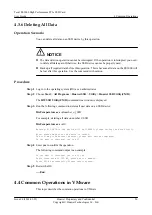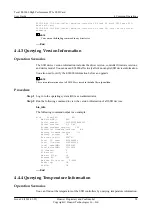
4.1 Operation Description
This topic describes the precautions to be taken before you operate an ES3000.
4.1.1 Naming Rules and Conventions of an ES3000
l
After you install the ES3000 driver in Linux, the system creates one SSD device for each
ES3000. If you install multiple ES3000s in the server, the SSD devices are named
hioa
to
hioz
.
l
After you install the ES3000 driver in Windows, the system detects each ES3000 as an
independent disk.
l
After you install the ES3000 driver in VMware, the system creates one character device
for each ES3000. If you install multiple ES3000s in the server, the character devices are
named
chioa
to
chioz
.
4.1.2 Operation Precautions
When using an ES3000, observe the following precautions:
l
If you install multiple ES3000s in the server, identify the mapping between labels and
ES3000s by
4.3.4 Setting E-Label Information
.
l
If you install multiple ES3000s in a server, you need only to install the driver once.
4.2 Common Operations in Linux
This topic describes the common operations in Linux.
4.2.1 Querying SSD Device Information
Operation Scenarios
During routine maintenance, you can run a command to query SSD device information, including
the version, type, bad block information, and wear status.
Procedure
Step 1
Log in to the operating system (OS) as an administrator.
Step 2
Run the following command to query the information about an SSD device, for example,
dev/
hioa
:
hio_info -d /dev/hioa
The following command output is an example:
hioa Size(GB): 803
Max size(GB): 803
Serial number: 030PXT10C9000007
Tecal ES3000 High Performance PCIe SSD Card
User Guide
4 Common Operations
Issue 04 (2014-03-05)
Huawei Proprietary and Confidential
Copyright © Huawei Technologies Co., Ltd.
45
















































